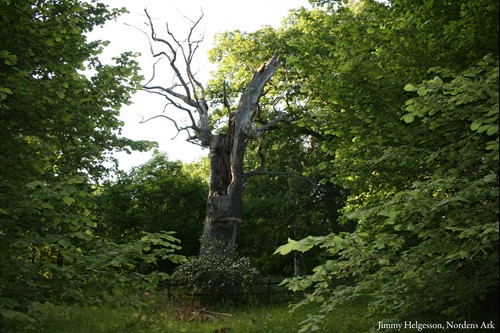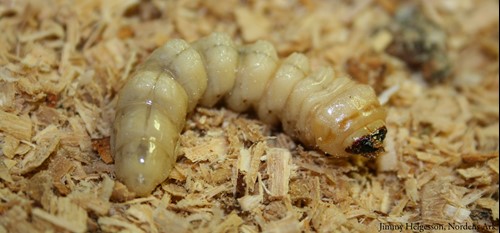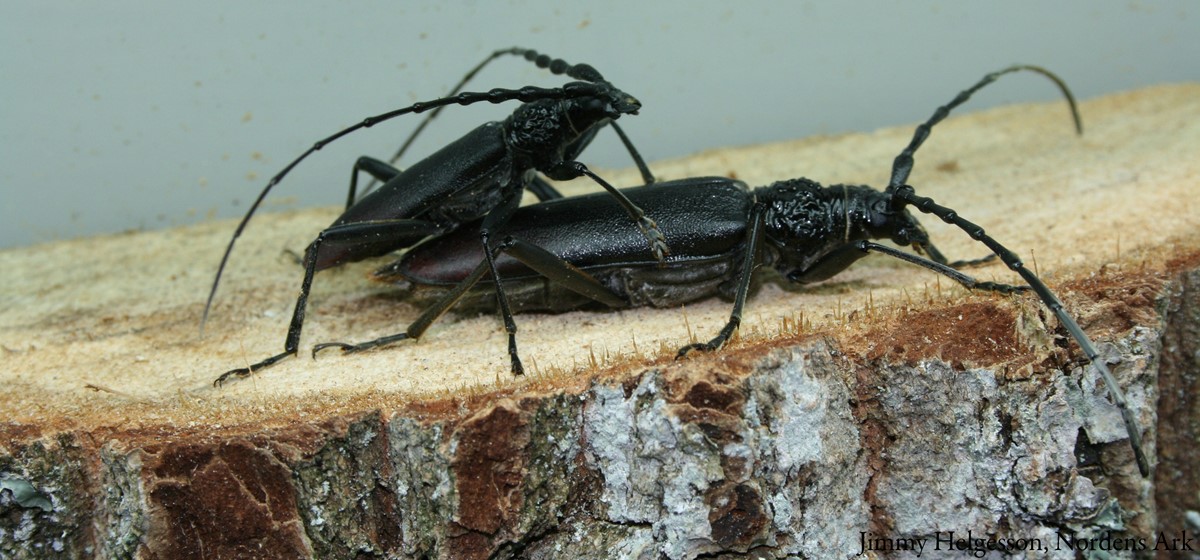Great capricorn beetle conservation
Great capricorn beetle is one of Sweden's rarest and most endangered insects. Its distribution area used to extend from Skåne, Blekinge, eastern Småland to Öland, but is now only found in one place in Sweden; namely in the nature reserve Halltorps hage on Öland. The species is already extinct in Denmark, Belgium, Holland, Luxembourg and Great Britain.
The absolute number one threat to great capricorn beetle is the loss of suitable habitat. The larvae live in living, very old oaks with thick bark and during the 1850s millions of such oaks were felled in meadows and pastures. This, together with the regulation of rivers and a general overgrowth of grazed oak forests, has led to the sharp decline of the species. Bigger is today classified as Critically Endangered on the Swedish Red List and Vulnerable on the IUCN Red List.

Old dead oak on Öland.
What we do at Nordens Ark
Since 2012, Nordens Ark has worked actively with the conservation of the great capricorn beetle. The work takes place in collaboration with the County Board in Kalmar and Blekinge counties, and within the framework of the national action program.
In order to re-establish the great capricorn beetle on the Swedish mainland, Nordens ark has developed a unique breeding method. A challenging task as there was no previous experience of breeding the species on a large scale, but after three years of hard work we finally had a working method. The species has three life stages; larva, pupa and beetle, where each stage requires a special treatment. The larvae are reared in petri dishes filled with a nutrient-rich food mixture mainly based on oak shavings. There, the larvae eat and grow large for two years until it is time to transition to the pupal stage. The pupae hatch into fully formed beetles a month later at the end of summer. The beetle must overwinter in a refrigerator to complete its life cycle and become reproductive.

Eggs are picked from pieces of logs in Nordens Ark's breeding facility.
With this method, we can now annually produce 150–300 great capricorn beetle for release. The first releases on the mainland took place in 2017 in Björnö and Tromtö nature reserves. Thanks to extensive restorations, there are now large contiguous oak environments and good conditions for the species to gain a foothold. Since 2017, 1220 great capricorn beetles have been able to be released, which has given good results. Namely, in 2022 the first hatching holes of great capricorn beetles were found on oaks where releases had previously taken place. It is a first sign that we have succeeded in re-establishing the species in its former range!
News from the project – December 2025
In 2025, 346 great capricorn beetles were released in the Tromtö Nature Reserve in Blekinge County.
At the Björnö Nature Reserve, emergence holes continue to be found, indicating that the species has established itself well there. Releases have therefore been paused in favour of surveys that will monitor the development of the population. During a field visit to Björnö, a wild-born great capricorn beetle was observed sitting low on the trunk of an avenue oak. The same tree had several new emergence holes, and additional fresh holes were recorded in several locations across the reserve.
In Tromtö, emergence holes have also been found on a number of oaks, although not to the same extent as in Björnö.

Great capricorn beetle larva.
Read more about the work on site in Halltorp's meadows here.
In collaboration with
Kalmar and Blekinge county administrative board.



